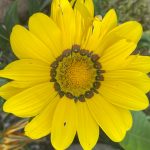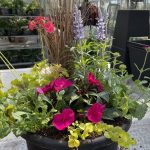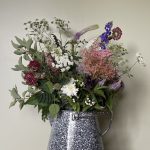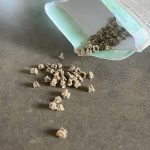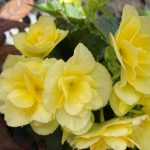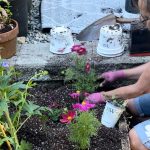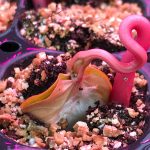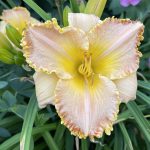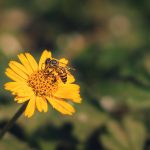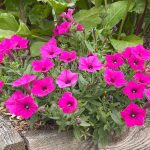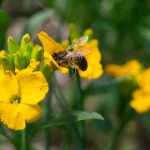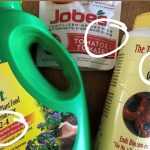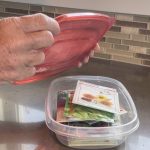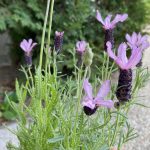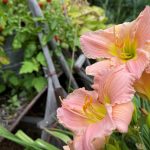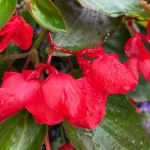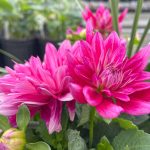Growing Geraniums are one of the backbones of gardening for us here in Edmonton and prairie regions. Geraniums are tough, hardy, can hold up in the cold and in the heat. If you take care of geraniums correctly, they will perform beautifully from the beginning of spring through to the cool mornings and evenings of fall.
Both Seed Geraniums and Geraniums from cuttings (vegetative Geraniums) are perfect for our climate. Ever wondered what the difference is between Geraniums from seeds and Geraniums grown from cuttings? In this blog we will discuss why grow Geraniums in the first place, what vegetative Geraniums are, what seed Geraniums are, how to use vegetative and seed Geraniums in your garden, and how to care for geraniums.
Why Grow Geraniums?
Geraniums are perfect for our central Alberta YEG and across-the-prairie environment. As a matter of fact, they are ideal for all of Alberta, Saskatchewan, Manitoba, and any location in Canada north of the 49th parallel.
Why are geraniums ideal plants for the northern hemisphere?
Well, for one, Geraniums are beautiful. Geraniums pack a solid punch of colour — they have amazing bright hues and they come in a wide array of colours from neon pinks and the softest of baby pinks, to reds, oranges, whites, and combinations thereof.
Geraniums are easy to grow and they are hardy. Geraniums will grow in a wide variety of environments and can take both our heat waves and our chilly weather. Geraniums will bloom deeply into fall and can even take a tiny little bit of frost.
What’s the correct name, ‘Pelargoniums’ or ‘Geraniums’?
The word ‘Geranium’ actually applies to perennial geraniums. The common name for perennial Geraniums is ‘Cranesbill’ because they produce a beak-like structure on their stems when the flower is done growing. Perennial Geraniums are native to North America and Europe.
The Geraniums we will be discussing here are more correctly called ‘Pelargoniums’. These are the ones we put in hanging baskets, containers, and in- ground plantings. Most pelargoniums are native to South Africa. They wound up in England with the seafaring traders and from there made their way to North America. There are 250 different species of Pelargoniums worldwide and over 10,000 different cultivars or varieties because Pelargoniums lend themselves so easily to crossbreeding. However, geraniums are a more commonly known name for the beautiful flower, so we will continue to call them geraniums.
Vegetative Geraniums
Why grow Geraniums from cuttings?
Geraniums are grown from cuttings or ‘vegetatively’ in the horticultural industry for consistency, so that the variety colour and growing habit is consistent with the label. All vegetative geraniums have some variation of semi-double flowers. Because of this kind of cultural or growing method, they tend to hold a higher price tag than seed geraniums.
The 5 basic groups of vegetative geraniums
All of the types listed below have an expansive range of colours.
1. Zonal Geraniums (H4)
Zonal Geraniums are often called ‘Common Geraniums’ because they are the most widespread and familiar of all the vegetative geranium types.
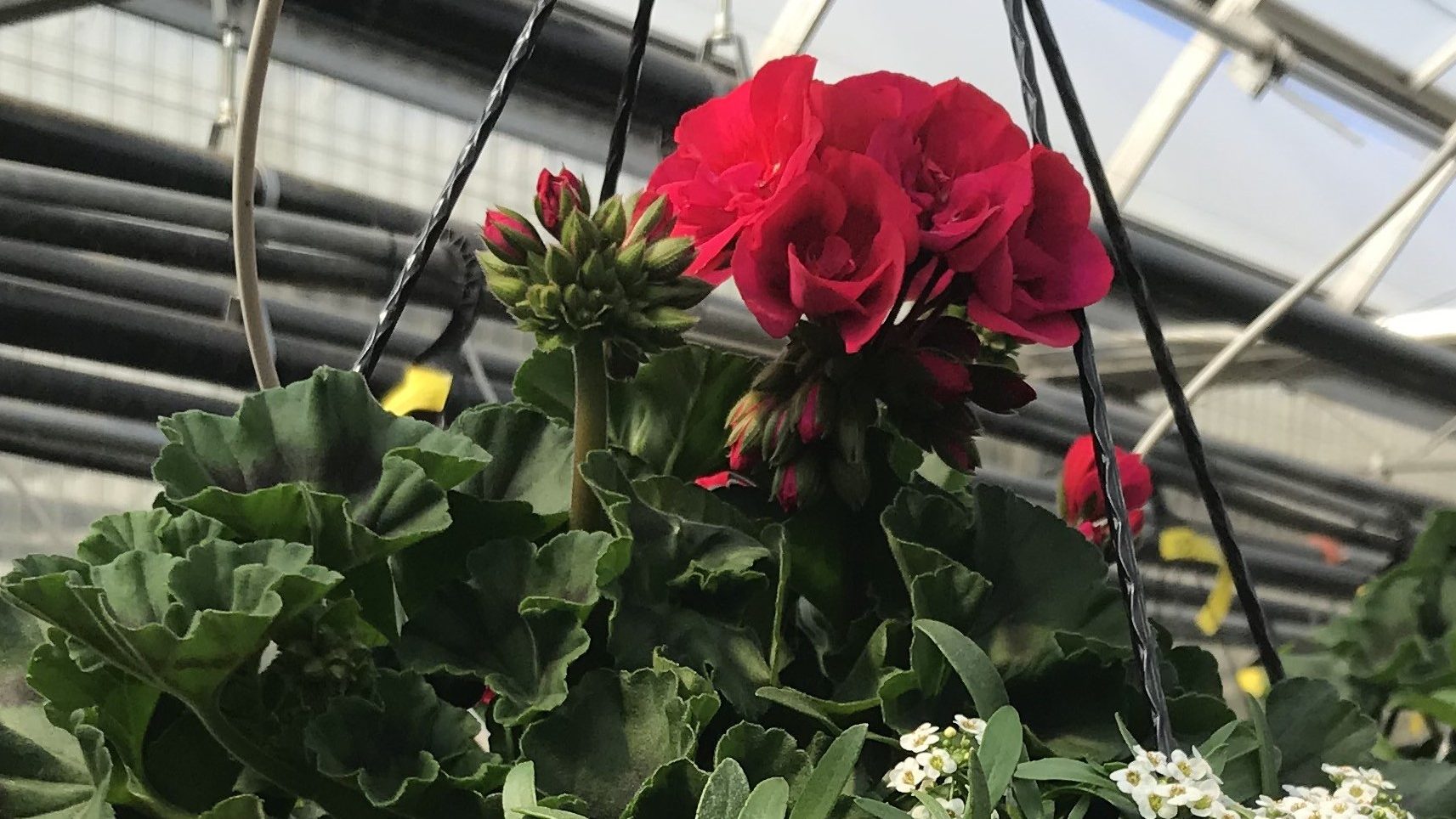
- Zonal Geraniums have velvety feeling leaves and distinct ‘zonal’ markings on their leaves that look like an arc set back from the leaf’s edge. It can be light or dark in colour. Please use the photo called Zonal Geranium here
- Zonal Geraniums grow upright in habit reaching 30-60 cm (1-2 feet) tall.
- Zonal Geraniums rarely need support or to be staked.
- They grow well in heat and can handle drier conditions once established. Persistent dry conditions are never recommended because they won’t thrive or grow well due to the constant stress. The first thing you will notice is decreased flowering when Geraniums are stressed.
- Series names like Dynamo, Fantasia, Galaxy, Sunrise and Moonlight are common and perform well.
Uses for Zonal Geraniums:
Because of their incredibly flexible growth habit and ease of care, the applications for Zonal Geraniums are broad and far reaching. Zonal Geraniums grow pretty much anywhere – in hanging baskets, upright containers, raised beds, planters, and in the ground in group or mass plantings.
2. Ivy Geraniums
Ivy Geraniums have a trailing habit and are often called ‘ trailing geraniums. You will see them ‘flowing’ out of containers like ivies do.
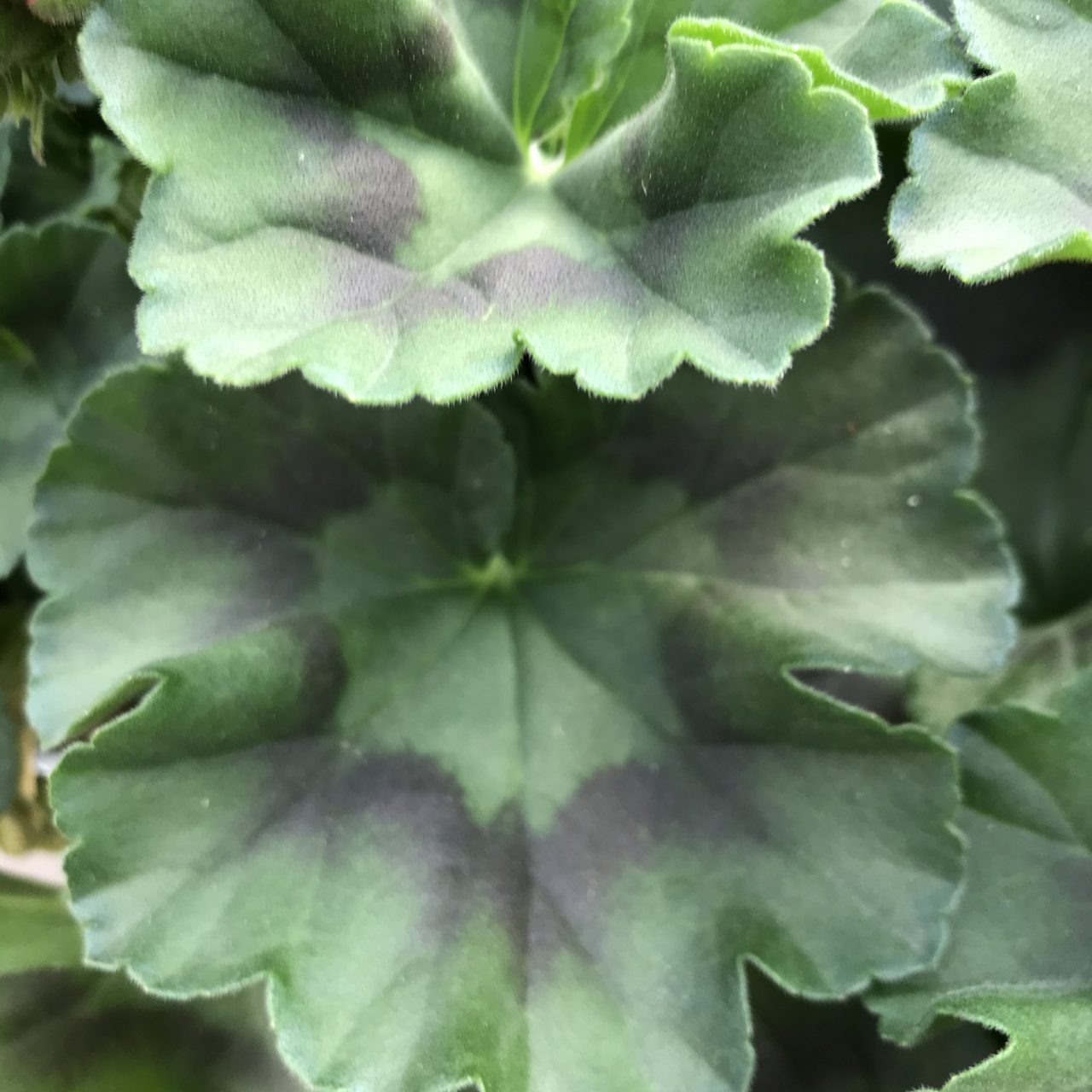
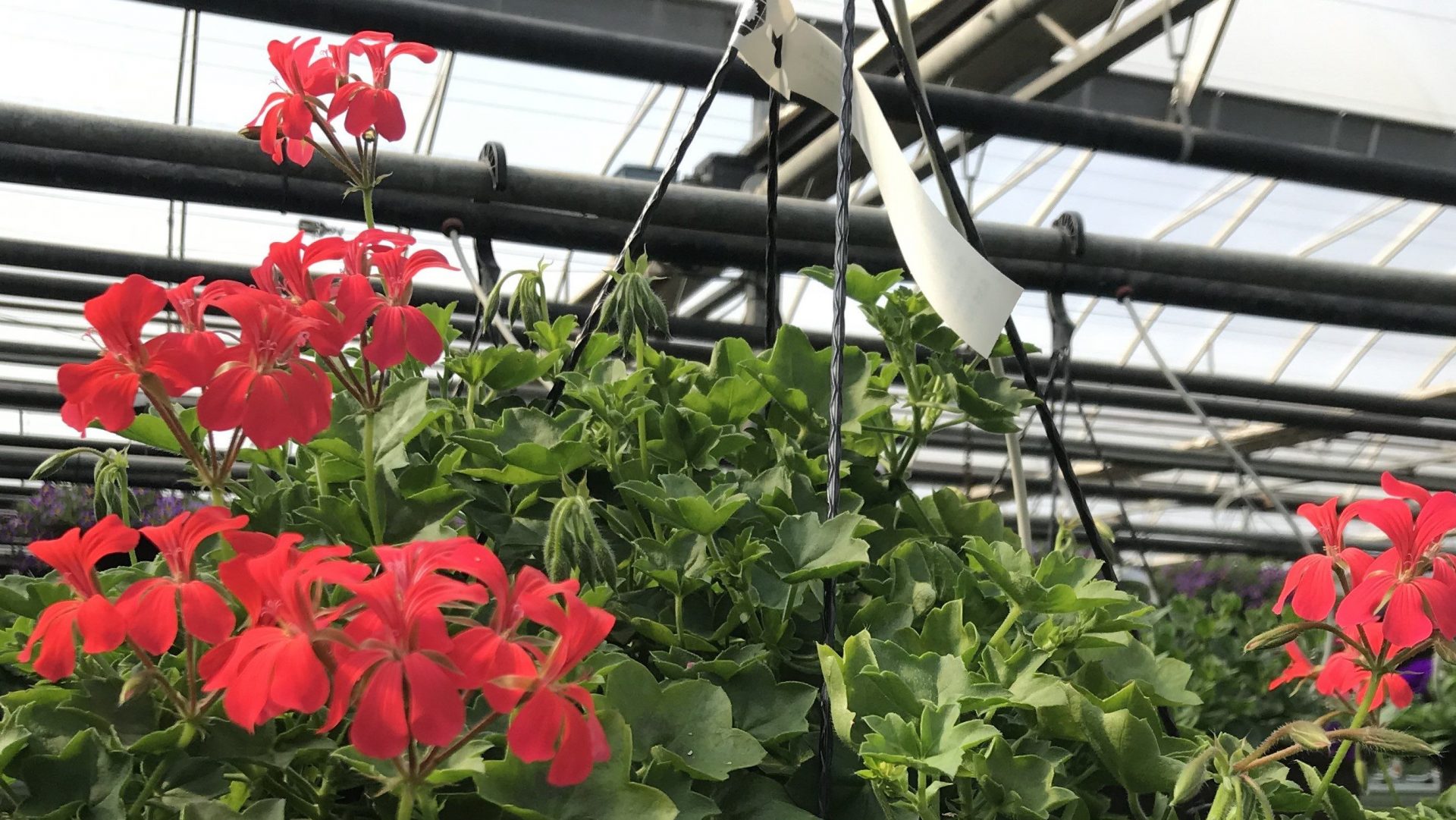
- The leaves of a true Ivy Geranium have a triangular shape like those of an ivy vine. The leaves are smooth and shiny and without markings like Zonal Geraniums.
- The leaves of a true Ivy Geranium have a triangular shape like those of an ivy vine. The leaves are smooth and shiny and without markings like Zonal Geraniums.
- Ivy Geraniums grow long, up to 60 cm (2 feet) in length.
- Ivy Geraniums can take the heat well and can handle some very dry conditions. Again, you never want to keep any plant persistently dry because it will negatively affect their performance.
- Series names like Focus, Precision and Royal are common and perform well.
Uses for Ivy Geraniums:
Ivy geraniums work well in hanging baskets, window boxes, and other containers where their trailing habit is beneficial to the flower mix.
3. Regal or Martha Washington Geraniums
Regal, also known as Martha Washington Geraniums, and sometimes called Pansy Geraniums, are a collection of vegetative geraniums that is considered to be an older class or heirloom geranium. They are from South Africa and are named after the wife of George Washington, the 1st president of the United States.
- Regal Geraniums grow upright in habit, reaching 30-60 cm (1-2 feet) tall and usually grow without support unless they are growing lopsided.
- The most attractive feature of this group is their unique bicoloured and ruffled flowers.
- Martha Washington Geraniums like to grow in cooler areas and will stop flowering when it gets too hot. An east or northeastern exposure, where they get a rest from the hot sun rays is best for this group of Geraniums. They provide great early spring colour while other plants are just starting to gear up for the season.
- Martha Washington geraniums are not as drought tolerant as the other classes.
- The Elegance series name, with varieties like Elegance Bravo, Elegance Red Velvet, or Lilac Majesty are common varieties that perform well.
Uses for Martha Washington Geraniums:
Martha Washington geraniums work best in upright containers or hanging baskets, either all on their own, or with a mix of other plants that like this same environment.
4. Scented Leaf Geraniums
Scented Leaf Geraniums are a fun and delightful group of geraniums because of their distinctively scented leaves.
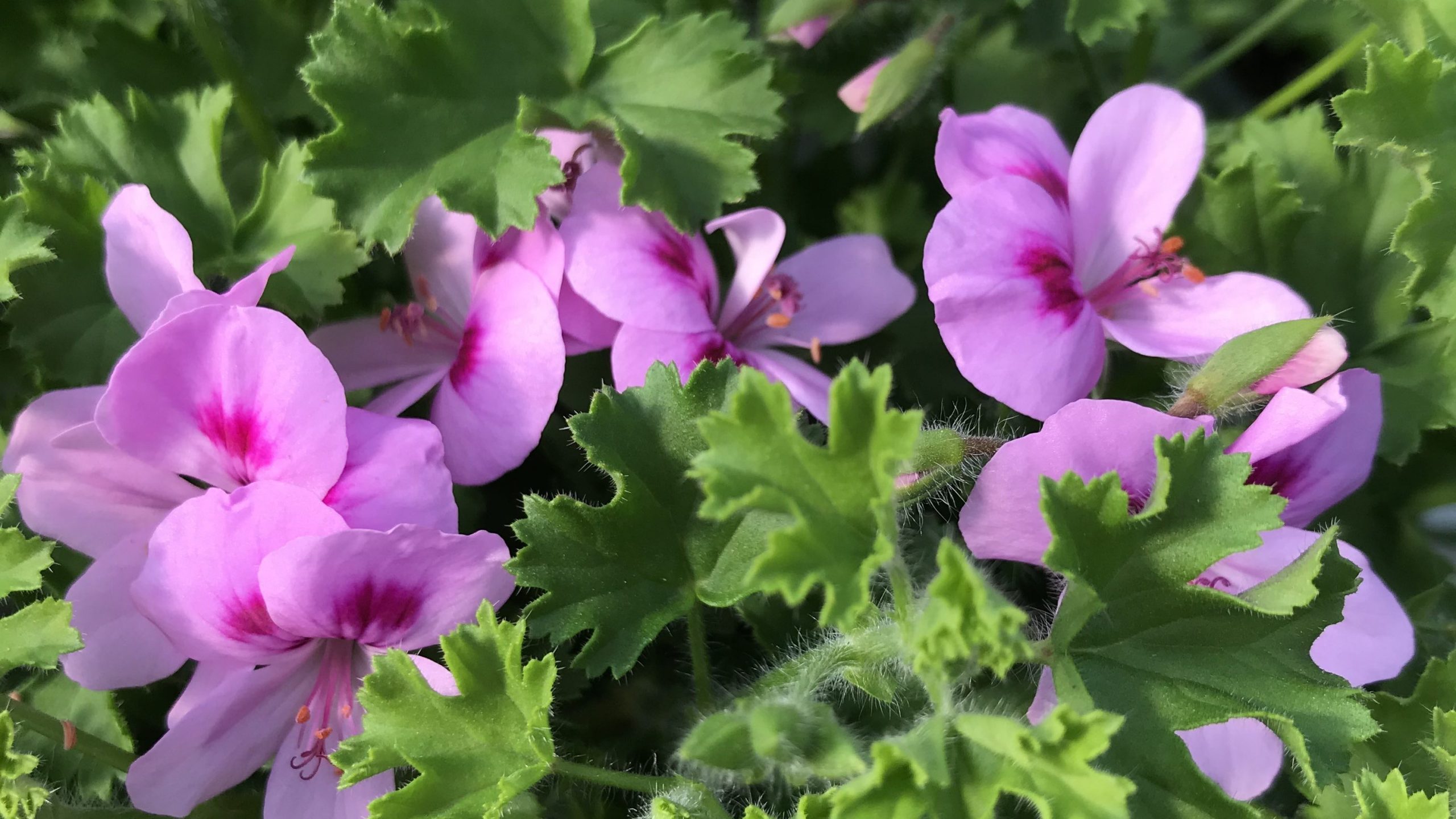
- Scented Leaf Geraniums have leaves that are ivy-like, can have slightly prickly edges, and they can feel either fuzzy or smooth.
- With an upright habit, Scented Leaf Geraniums usually grow to a height of about 45 cm (18 inches). In most cases, they don’t need support unless they’re growing wonky or lopsided.
- The flowers of this class are quite small and some are semi-double and others are single. The most common colour is pink, and sometimes it is 2 toned.
- Scented Leaf geraniums grow in full sun, can take the heat, and can handle drier conditions. As with all geraniums, don’t abuse this trait by keeping them relentlessly dry because their overall performance will be compromised.
- There are many kinds of scented geraniums like nutmeg, lime, and apple, but rose and lemon scented are the most popular.
- Names like Citronella and Citrosa are common varieties that perform well.
Uses for Scented Leaf Geraniums:
Scented Leaf Geraniums are often used in upright containers to repel mosquitoes. When the leaves are rubbed, they release a lemon scent that mosquitoes don’t like. They can also be used in hanging baskets, window boxes, and in the ground with or without other plants that grow in the same environmental conditions.
5. Interspecific Hybrid Geraniums
Interspecific Hybrids are a newer class of geranium created by crossing zonal geraniums with ivy geraniums resulting in vigorous growth and new colours.

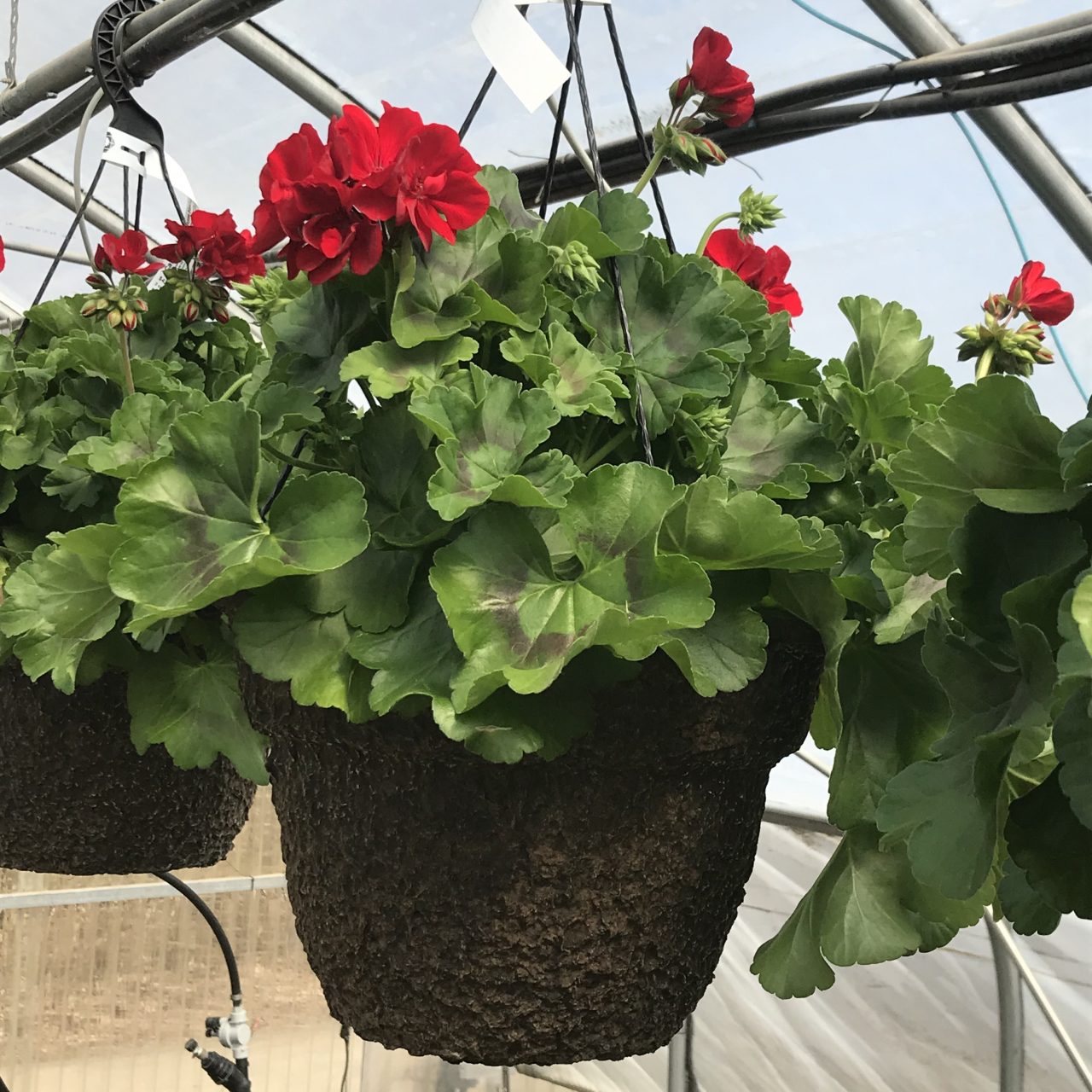
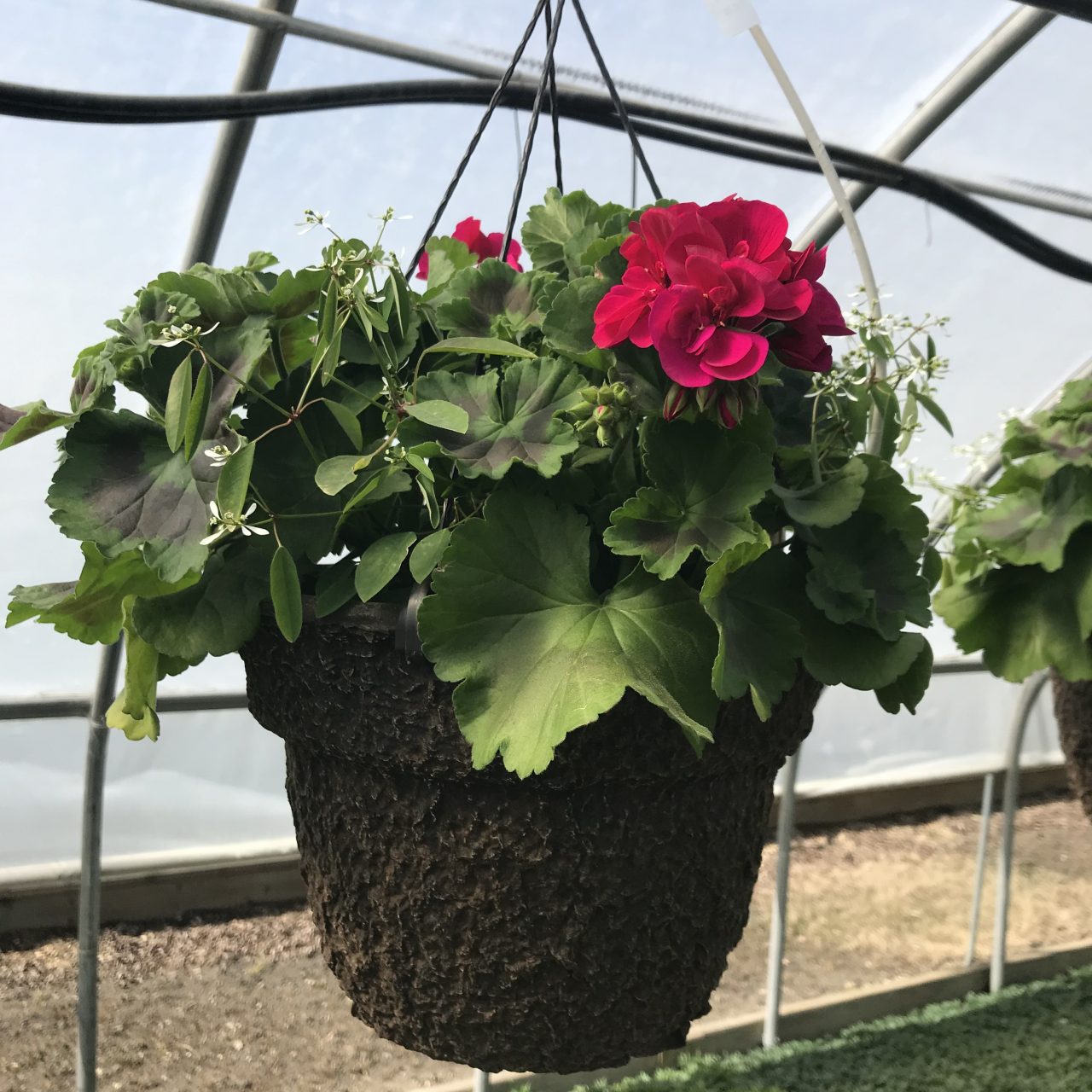
- Interspecific Hybrid Geraniums are the most heat tolerant of all Geraniums and they have very energetic branching, both upright and vining. They also tolerate drier conditions but don’t keep them dry incessantly — they will stop blooming, and you will see leaves start to dry out and crisp.
- Interspecific hybrids grow 30-60 cm (1-2 feet) in length with a vining, overflowing habit, yet maintain a good upright dome.
- Two popular series in this collection are named Calliope (pronounced ‘cal-eye-oh-pea) and Caliente. The Calliope leaf structure is more like that of a zonal geranium and the leaves of the Calientes bear a resemblance to the ivy geraniums. Both boast of a variety of deep bright colours. Calliope varieties have semi-double flowers and Caliente varieties tend to be more singular.
Uses for Interspecific Hybrid Geraniums
The Interspecific Hybrids work wonderfully in hanging baskets and gain more popularity each year. They work well in upright containers needing spillage over the edge and pair well with other plants of the same environmental needs.
Seed Geraniums
Seed Geraniums are Geraniums that are propagated from seed. The impetus to develop geraniums from seed came from 3 different paths:
Geraniums from Seed Have Reduced Viral Infections
The horticultural industry needed to come up with a solution to the recurring problem of viral infections among the vegetative geranium crops. Viral infections are still problematic and cuttings are inspected on a regular basis to this day.
Geraniums from Seed Have More Plant Vigour
There is also an issue with the continued propagation of old vegetative geranium varieties – plant vigour gets lost over time. That’s why there is always a need to develop new zonal geranium varieties. Dr. Richard Craig from Pennsylvania State University is credited for developing the first seed geranium variety in the 1960s.
Geraniums from Seed are Less Expensive
Seed geraniums are an economical answer to vegetative geraniums because seed geraniums are less expensive to grow and less expensive for the consumer. Geranium cuttings are costly and require higher tech equipment and conditions to root.
Characteristics of Seed Geraniums
Seed Geraniums are vigorous growers, free flowering, and available in a wide offering of colours. Their flower heads usually consist of a collection of single flowers. The blossom colours are not always as bright as vegetative, but the breeders are continuing to develop brighter colours. Please insert the seed geranium photos 1-4 as needed.
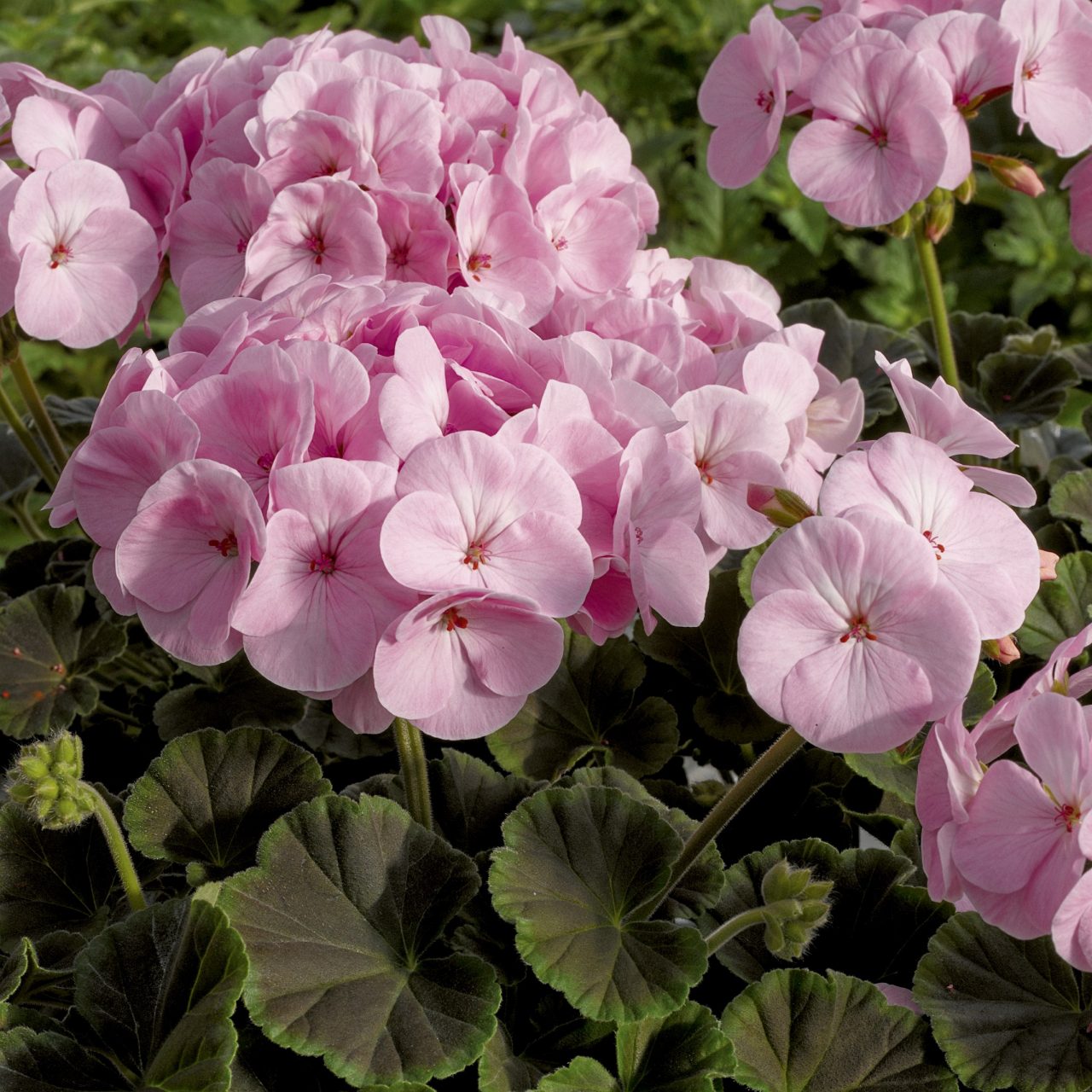
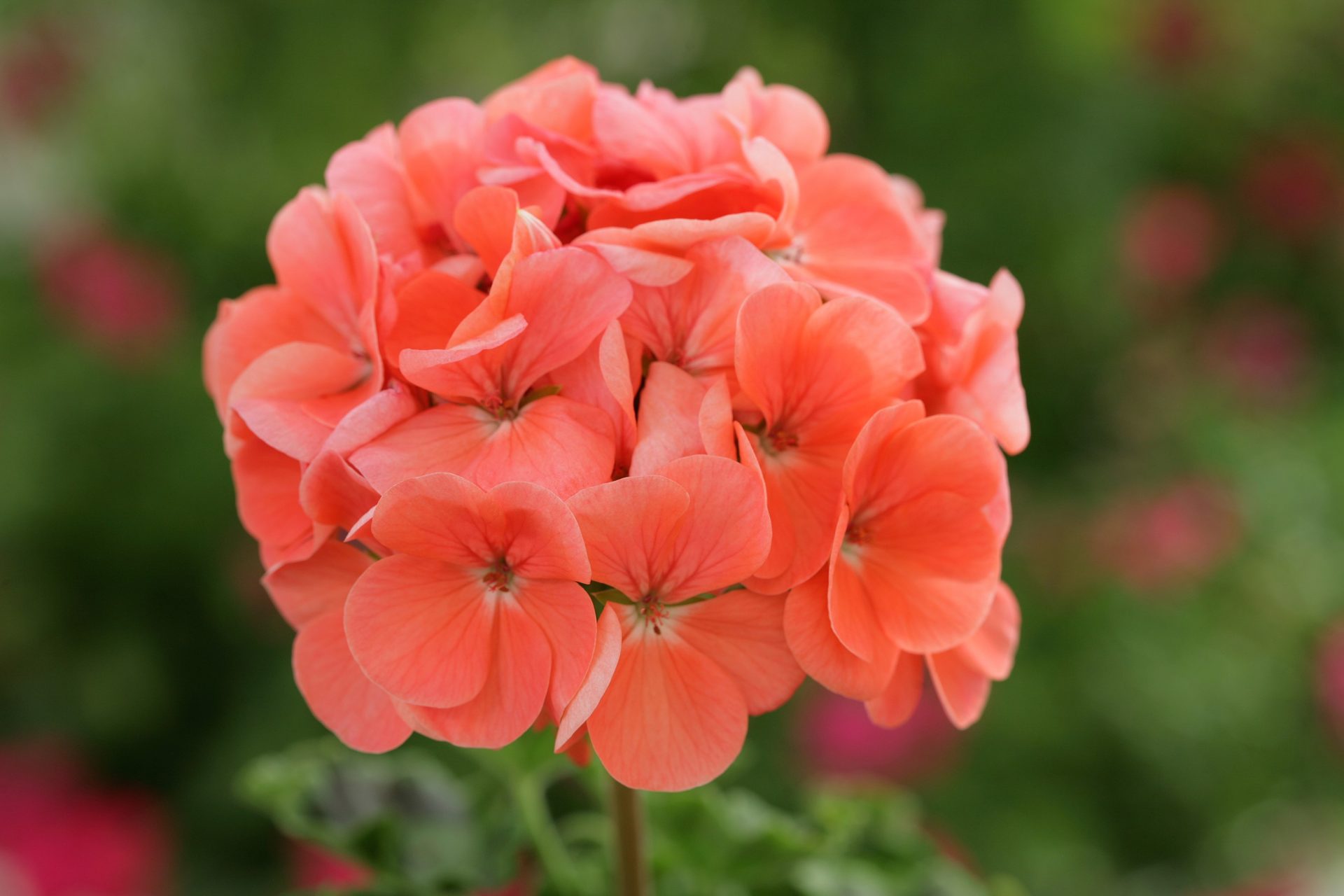
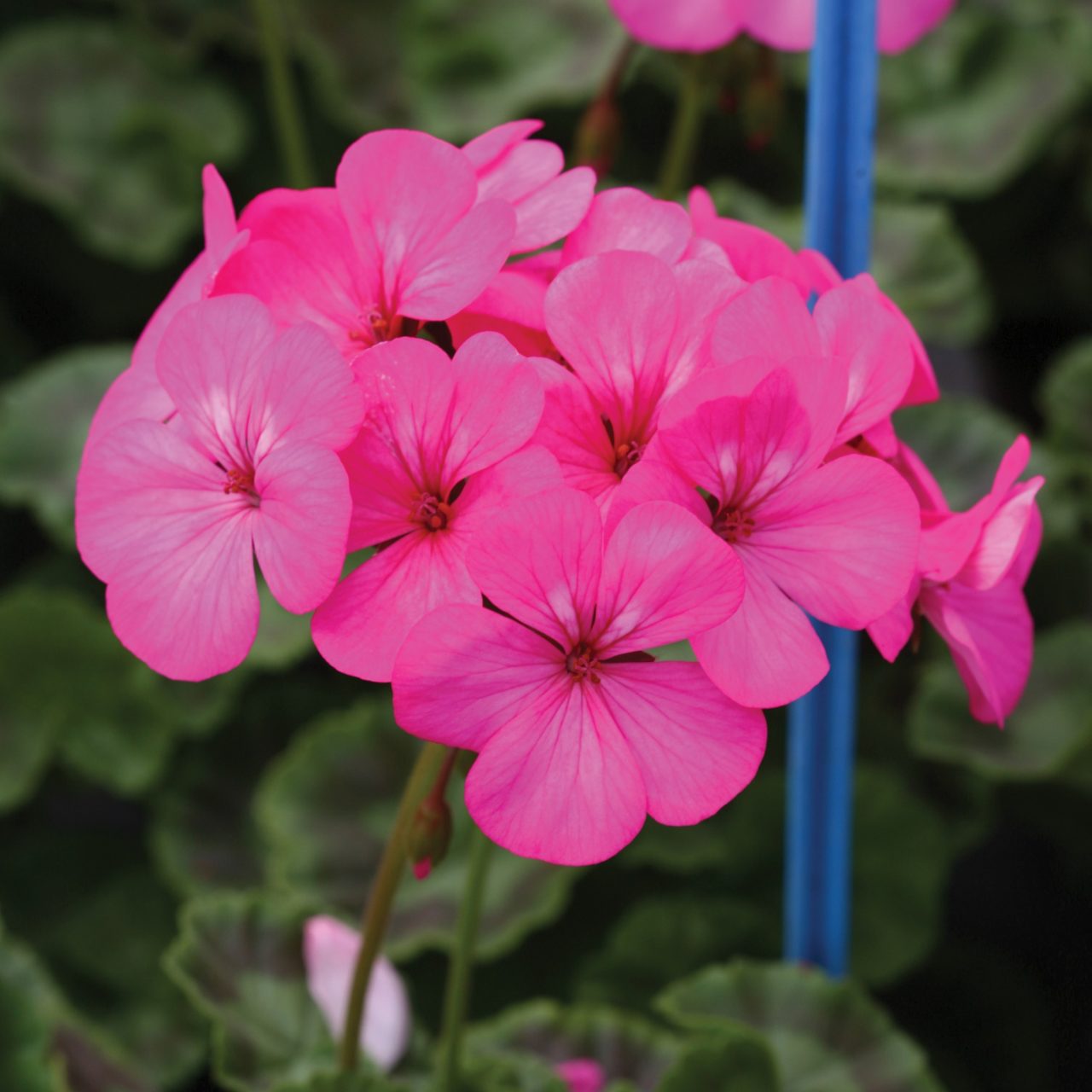
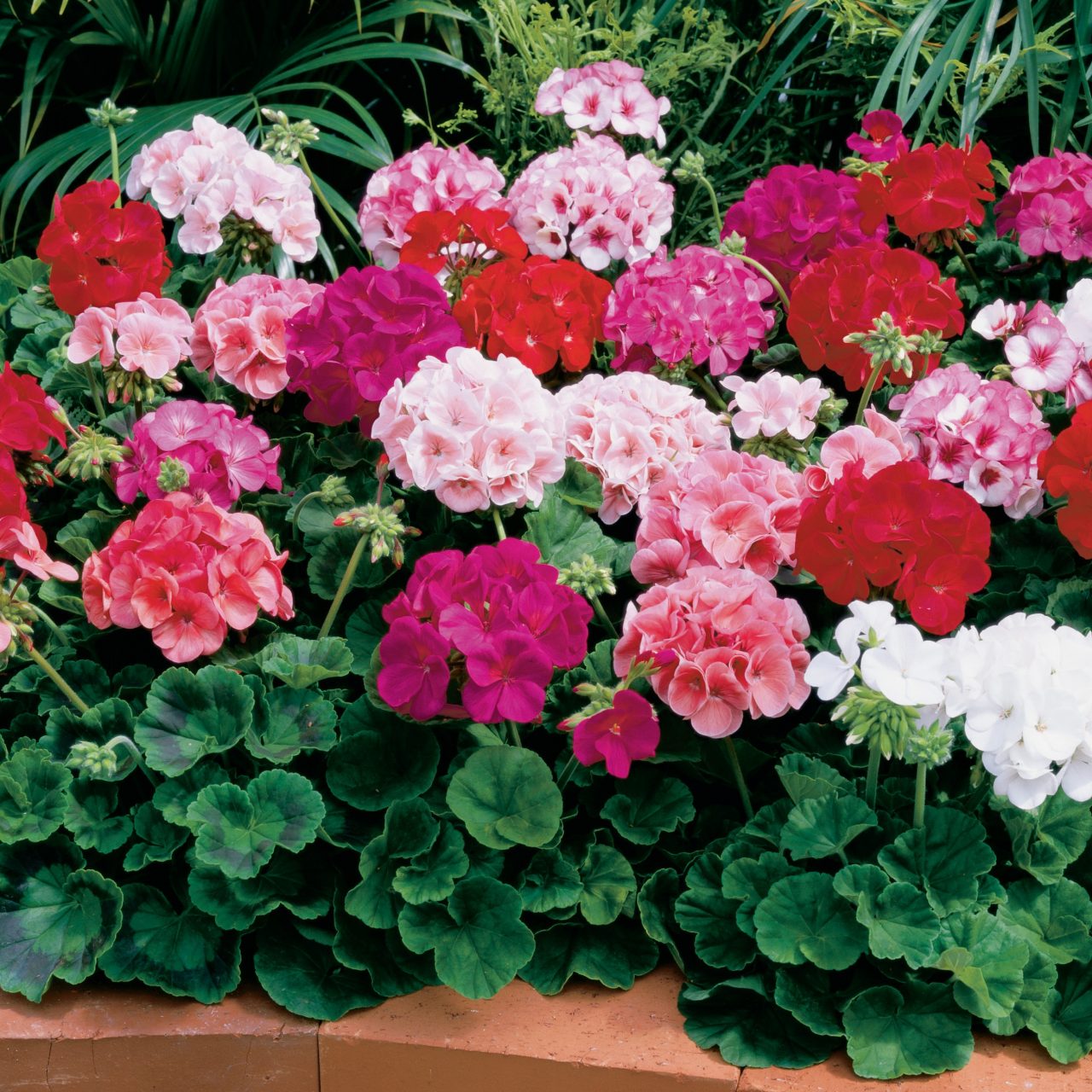
- Blossom shattering can be a problem with Seed Geraniums. Blossom shattering is when the flower petals fall off of the flower heads in response to some kind of physical assault like wind, rain, or getting brushed by a passerby. The newer varieties are holding their flowers better.
- Seed Geraniums grow to 30 – 45 cm (1½’ tall), a little smaller than vegetative.
- Seed Geraniums also have good disease resistance.
- Seed Geraniums grow well in hot sunny areas, tolerating drier conditions once established. Persistent dry conditions are never recommended because they won’t thrive or grow well due to the constant stress.
- Seed Geraniums work well in smaller containers like in window boxes as the feature plants – they won’t take over the entire container as they grow. And they work well in mass plantings because of their lower price.
- Be on the lookout for series names like Horizon, Bullseye, and Maverick when looking to purchase Seed Geraniums.
Uses for Seed Geraniums
Environmentally, Seed Geraniums work well in hot, sunny areas just like Vegetative Geraniums, however I believe that Ivy Geraniums and Interspecific Hybrid Geraniums have better heat and drought tolerance than Seed Geraniums do. Smaller containers like in window boxes are ideal for Seed Geraniums as the feature plants – they won’t take over the entire container as they grow and they work well in mass plantings because of their lower price.
How to Care for Geraniums
Whether from seed or from cuttings, Geranium care is the same. Follow these guidelines for the best Geranium performance:
- Geraniums are sun lovers, except for the Martha Washington types. Geraniums need a bare minimum of 6 hours of direct sun. The more sun, the better.
- Grow Geraniums in good quality, well draining soil, and keep them evenly moist. Geraniums can tolerate both drier or wetter conditions, but they won’t thrive if either condition lasts persistently.
- Fertilize weekly with a water-soluble fertilizer like 20-20-20, or 15-30-15 to keep the nutrients flowing to power healthy growth and abundant flowering.
- Remember to deadhead your Geraniums regularly, which is taking off the old blossoms when the flower petals are dry to encourage continual flowering. If the old flowers are left on, that signals the Geraniums to produce seeds so they will dedicate their energy to producing seeds and it will halt flowering.
Wrapping up Geraniums
Geraniums are a great gardening bet for novice and experienced gardeners alike for reliability, resistance, and overall performance. Both seed and vegetative geraniums grow in warm sunny locations and will spoil you with vibrant colour all season long.
Check out my Vegetative Geraniums and Seed Geraniums Comparison Chart to pick the geranium that is right for you.
Let me know if I can help with any questions, just message me and I will get back to you. Happy Gardening!
© Sharon Wallish Murphy, Gardening with Sharon



